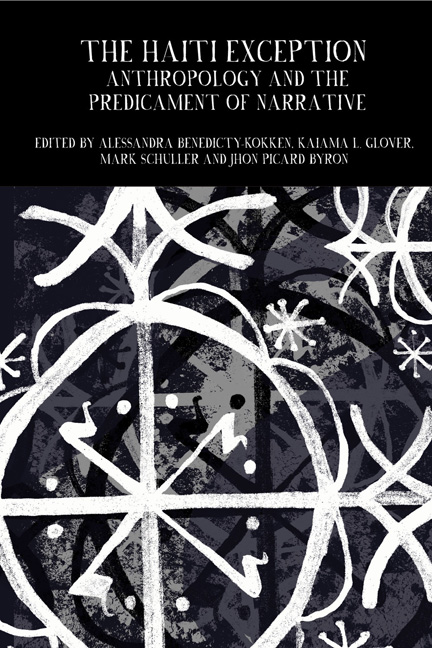Book contents
- Frontmatter
- Contents
- Editors’ Introduction
- I Tracing Intellectual Histories
- II Interrogating the Enquiring Self
- ‘Written with Love’: Intimacy and Relation in Katherine Dunham's Island Possessed
- Dance, Haiti and Lariam Dreams
- ‘Haitian Art’ and Primitivism: Effects, Uses and Beyond
- III On Nation-Building: Histories, Theories, Praxes
- Epilogue: Kalfou Danje: Situating Haitian Studies and My Own Journey within It
- Notes on Contributors
- Index
‘Haitian Art’ and Primitivism: Effects, Uses and Beyond
from II - Interrogating the Enquiring Self
- Frontmatter
- Contents
- Editors’ Introduction
- I Tracing Intellectual Histories
- II Interrogating the Enquiring Self
- ‘Written with Love’: Intimacy and Relation in Katherine Dunham's Island Possessed
- Dance, Haiti and Lariam Dreams
- ‘Haitian Art’ and Primitivism: Effects, Uses and Beyond
- III On Nation-Building: Histories, Theories, Praxes
- Epilogue: Kalfou Danje: Situating Haitian Studies and My Own Journey within It
- Notes on Contributors
- Index
Summary
I shall take as my point of departure an objection that was once addressed to me as an occasion to interrogate certain critiques of primitivism and to expose the impasses to which such critiques might lead. Primitivism, a gaze that relegates the Other to some original state of being, is a projection. The question is to figure out whether the object or person on which or on whom such a discourse is projected can be thus simplified, including when that thing or person has been appropriated – that is, taken hold of and reworked. In the end, there are multiple levels of analysis at stake – always remaining to be clarified when it comes to the plastic arts, where the complex matter of the relationship between production, circulation and reception is in question. We might position ourselves at one given level of analysis or seek to articulate several at once. Yet, when it comes to Haiti, there is a tendency to privilege a single register – a register presumed to be exclusive, definitive.
Objection!
Invited to participate in a research seminar, I presented data from some current research. The question at hand was that of the place of the body in the creative process. This was an interesting perspective on two levels for it offered me an as yet unexplored entry into existing scholarship related to the subject of my research, and it seemed an ideal opportunity to begin thinking about the new art scene. In the new creative forms that began to appear in the 1980s and throughout the 1990s, the body seemed to have great importance. Of course, the body is never absent from the creative process, but the way in which it is implicated in the different stages of this process can vary. Presumably, the new art scene, was mobilizing it – implicating it in the creative process, presenting and representing it in the works – differently than in earlier styles. An example: Lionel St-Eloi's shift from painting on canvas to the construction of three-dimensional objects using recycled materials! He discovered this new approach at the beginning of the 1990s as a way of circumventing the difficulty of acquiring tubes of paint during the economic embargo imposed upon Haiti following the ousting of Jean-Bertrand Aristide.
- Type
- Chapter
- Information
- The Haiti ExceptionAnthropology and the Predicament of Narrative, pp. 120 - 134Publisher: Liverpool University PressPrint publication year: 2016

